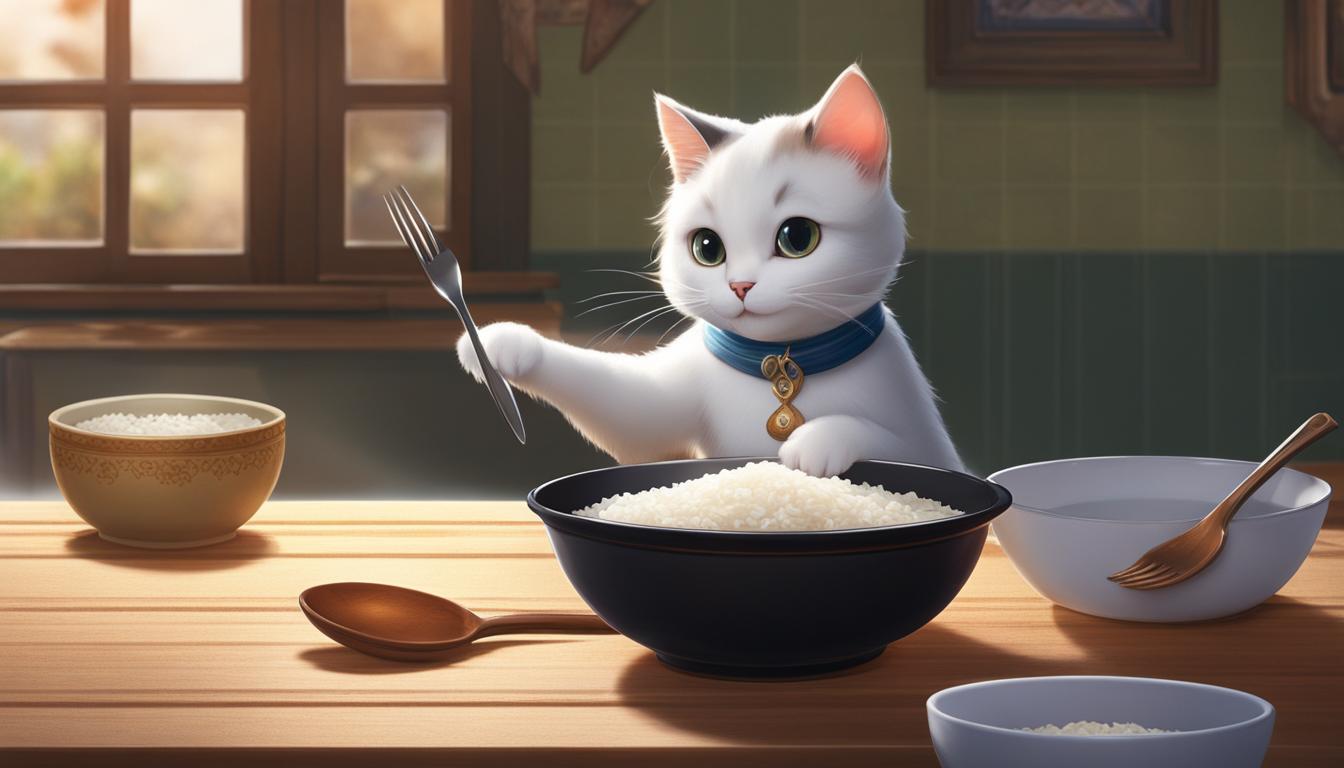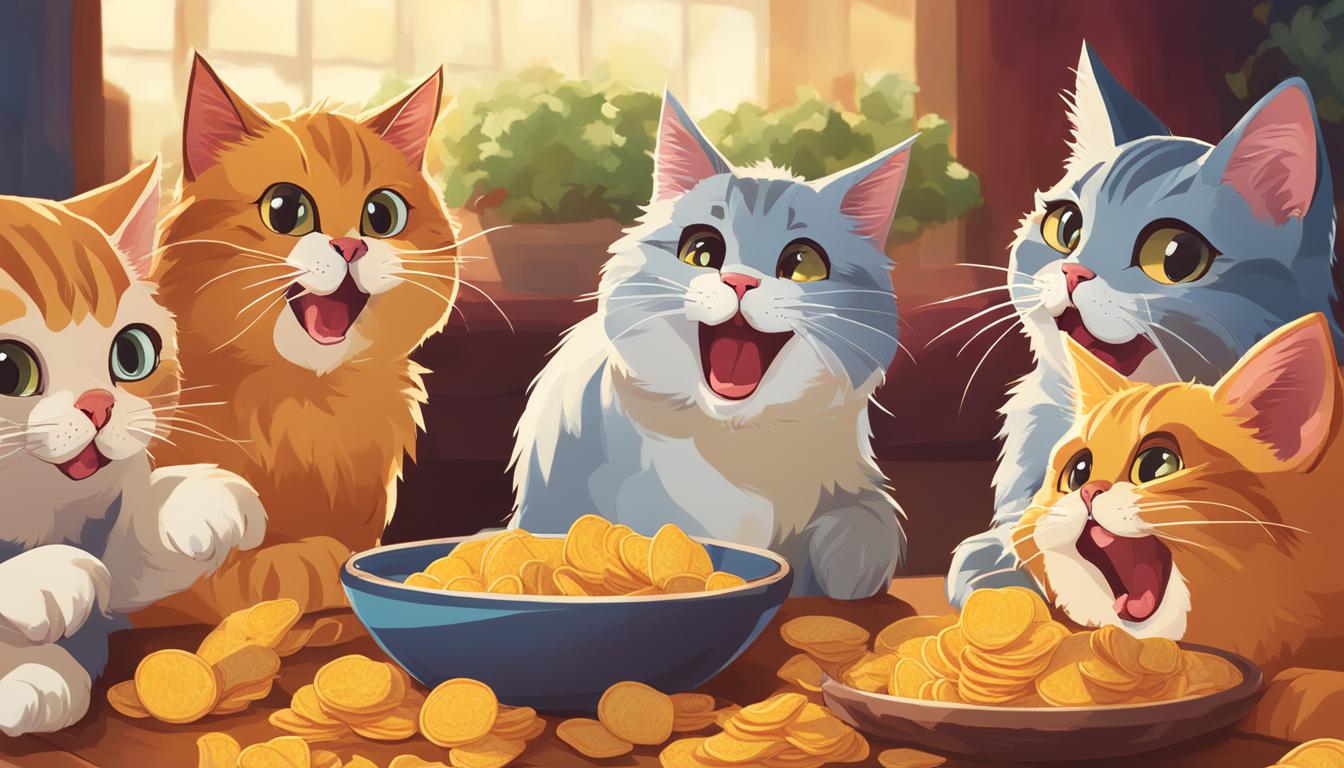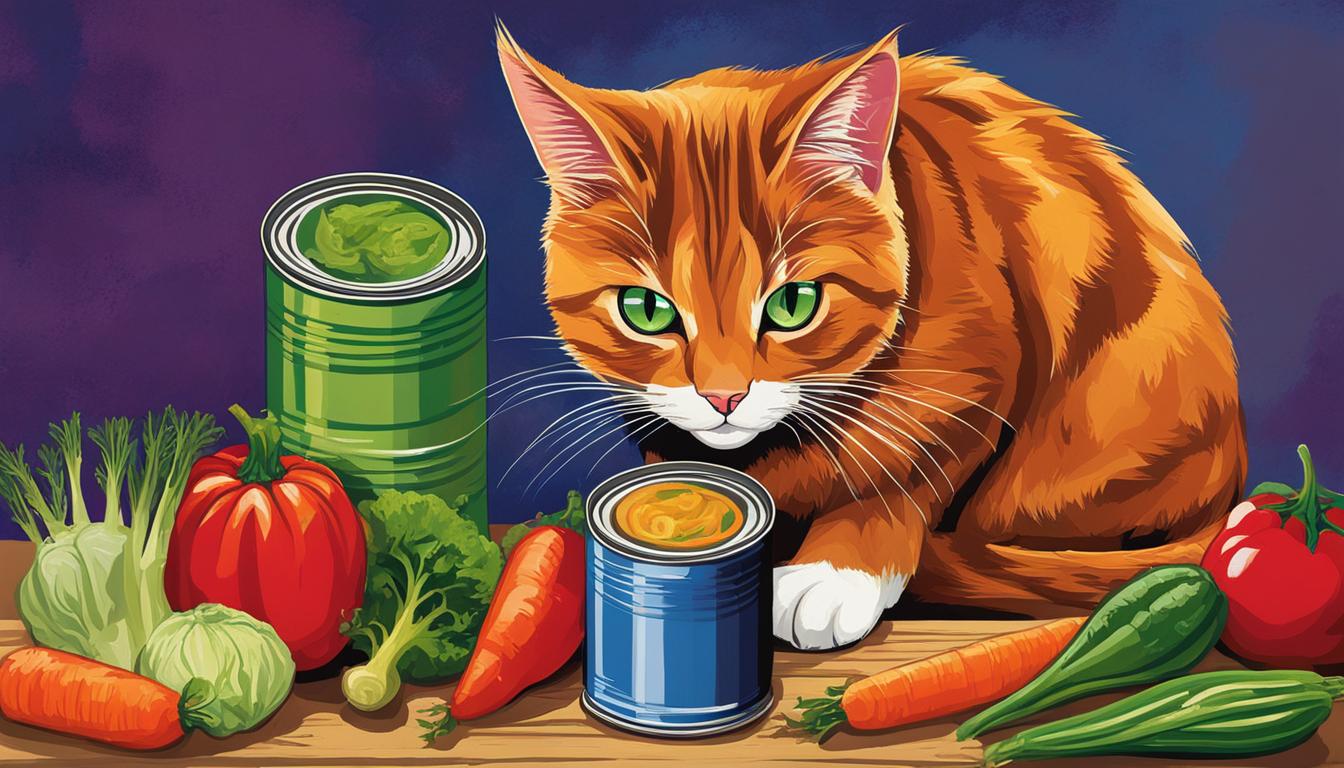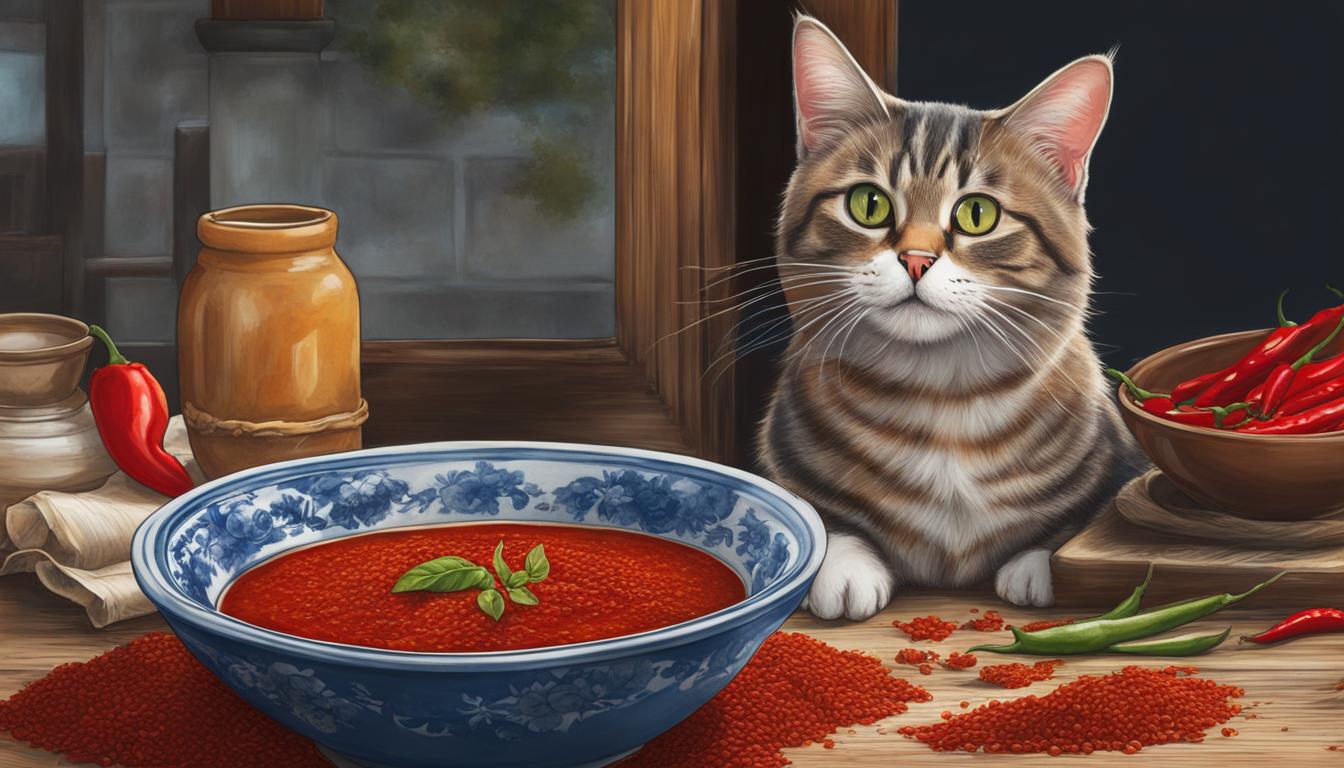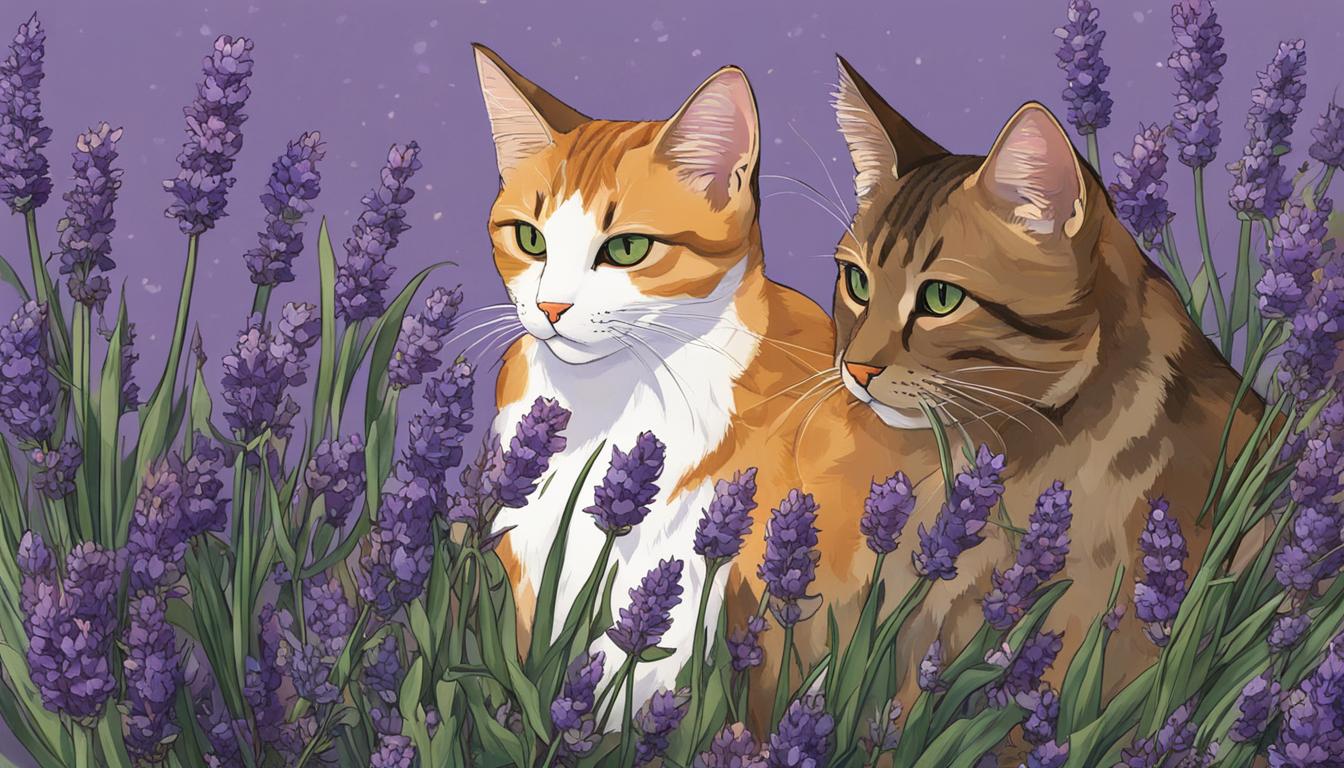Greetings, fellow cat enthusiasts! Today, let’s explore a burning question that has surely crossed the minds of many cat owners – can our furry friends indulge in the delights of rice and pasta? As a curious cat lover myself, I embarked on a quest for answers, so let’s dive right in!
Now, I’m sure you’re wondering if cats can munch on rice. Well, the truth is, they can. However, rice is not an essential component of their diet. In fact, rice is more of a filler food with little to no nutritional benefits for our obligate carnivore companions. While brown rice is a slightly better choice nutritionally, both white and brown rice should only be given in tiny quantities. Why, you ask? Because too many carbs in a cat’s diet can lead to unwanted obesity!
But what about pasta, you may be pondering? Sadly, pasta falls into the same category as rice. It lacks valuable nutrition for our feline friends and can even cause tummy troubles. So, while our cats may have a curious inclination towards our Italian-inspired meals, it’s best to resist their begging eyes when it comes to pasta.
Remember, my fellow cat lovers, our furry friends flourish on a diet rich in animal protein and fats. Grains and carbs are unnecessary additions that can do more harm than good. So, let’s prioritize their health and well-being by providing them with the quality cat food they deserve.
Key Takeaways:
- Rice and pasta are not nutritional necessities for cats, as they are obligate carnivores.
- Both rice and pasta should be given in minimal amounts to avoid weight gain and gastrointestinal issues.
- Animal protein and fats should form the basis of a cat’s diet.
- Consult with a veterinarian for specific dietary advice tailored to your cat’s individual needs.
- Avoid homemade rice cat food recipes and prioritize high-quality cat food instead.
Risks and Considerations of Feeding Cats Rice
When it comes to feeding cats rice, there are several risks and considerations to keep in mind. While cats can technically eat rice, it is not a necessary or nutritionally valuable part of their diet. In fact, rice is considered a filler food with no significant benefits for cats.
The main concern with feeding cats rice is its impact on their digestive health. Uncooked rice, in particular, can be difficult for cats to digest and may cause gastrointestinal issues. To ensure the rice is safe for consumption, it must be thoroughly cooked without any seasonings or sauces. It is also important to note that a large amount of rice can contribute to obesity in cats due to its carbohydrate content.
Brown rice is often considered nutritionally better than white rice, but it should still be given in moderation. Cats have a limited ability to digest grains, and brown rice can be harder for them to process compared to white rice. While rice can be beneficial for cats with digestive issues such as diarrhea, it should not be used as a permanent solution and should be carefully monitored by a veterinarian.
| Type of Rice | Risk Level |
|---|---|
| Uncooked Rice | High risk for digestive issues |
| White Rice | Moderate risk if given in moderation |
| Brown Rice | Higher risk due to difficulty in digestion |
While it may be tempting to offer your cat rice as a treat or to supplement their diet, it is important to prioritize their nutritional needs. Cats are obligate carnivores, meaning their diet should primarily consist of animal protein. Instead of rice, focus on providing high-quality cat food that meets their nutritional requirements.
The Impact of Pasta on a Cat’s Diet
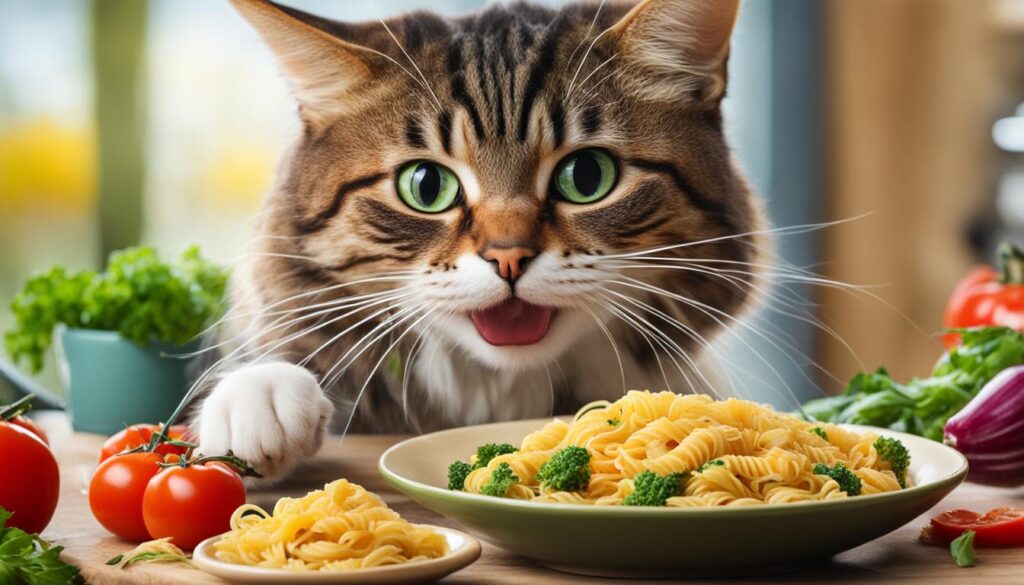
When it comes to a cat’s diet, pasta is not an ideal choice. Cats are obligate carnivores, which means their bodies are designed to thrive on a high-protein diet. Pasta, on the other hand, is high in carbohydrates and lacks the essential nutrients that cats need to maintain optimal health.
Feeding kittens rice or pasta is not recommended either. Kittens require a diet rich in high-quality animal protein for proper growth and development. Introducing grains and carbohydrates at a young age can disrupt their nutritional balance and potentially lead to long-term health issues.
Furthermore, there are no gluten-free pasta options specifically designed for cats. Some pet owners may consider offering gluten-free pasta to their feline companions, but it’s important to note that cats do not require pasta or any other form of carbohydrates. Their bodies are not equipped to efficiently digest and utilize plant-based nutrients.
The Nutritional Value of Pasta for Cats
In terms of nutritional value, pasta falls short compared to other cat-friendly food options. It provides little to no essential nutrients that cats need to thrive. Instead, cats should primarily consume animal protein and fat, which are crucial for their overall health and well-being.
“Pasta is not a natural part of a cat’s diet. Cats are obligate carnivores, meaning their nutritional needs are best met through animal protein sources. Feeding cats pasta only adds unnecessary carbohydrates to their diet and can lead to weight gain and other health issues.”
While small amounts of cooked pasta may not harm your cat, it is important to remember that it should never make up a significant portion of their diet. Instead, focus on providing them with nutritionally balanced cat food that meets their specific dietary needs.
| Pasta | Cat’s Nutritional Needs | |
|---|---|---|
| Protein | Low | High |
| Fat | Low | Medium to High |
| Carbohydrates | High | Low |
| Vitamins and Minerals | Limited | Essential |
As the table above illustrates, pasta does not adequately meet a cat’s nutritional needs. It is essential to prioritize their health by providing them with a balanced diet that focuses on high-quality animal protein and the right amount of fat.
Best Diet for Cats: Animal Protein and Fat
When it comes to the diet of our feline friends, it’s important to provide them with the optimal nutrition they need to thrive. Cats are obligate carnivores, which means their bodies are designed to primarily digest animal protein and fat. This is why it’s crucial to prioritize these nutrients in their diet and limit the inclusion of grains or carbohydrates. Homemade rice cat food recipes may seem like a viable option, but they are not recommended for long-term cat nutrition.
Alternative grains for cats are limited, as grains don’t naturally provide the essential nutrients that cats require. While some grains like rice may be digestible for cats in small amounts, it’s important to note that they don’t offer significant nutritional value. Mixing rice in a cat’s diet can lead to an imbalance in their taurine levels, which is a critical amino acid that cats need for proper heart and eye function.
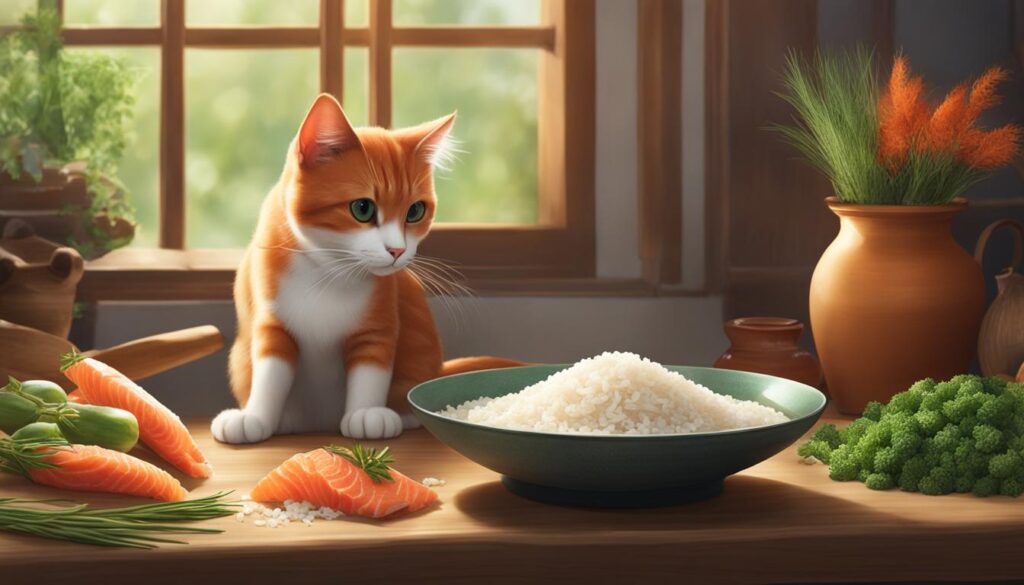
The Importance of Animal Protein and Fat
Animal protein and fat should make up the majority of a cat’s diet, comprising at least 70% of their meals. Cats have unique dietary requirements that can only be met by consuming animal-based ingredients. These nutrients are essential for muscle maintenance, energy production, and overall health.
While there are no alternative grains that are suitable for cats, there are commercially available cat food options that provide a balanced and complete diet. These cat foods are specifically formulated to meet the nutritional needs of cats, ensuring they receive the right balance of protein, fat, and other essential nutrients. It’s always best to consult with a veterinarian for personalized dietary recommendations based on your cat’s specific needs.
| Nutrient | Source |
|---|---|
| Protein | Meat, poultry, fish |
| Fat | Meat, poultry, fish |
| Vitamins | Fortified cat food |
| Minerals | Fortified cat food |
As responsible cat owners, it’s our duty to prioritize our feline companions’ health by providing them with a diet that aligns with their biological needs. While the idea of incorporating rice into homemade cat food may seem appealing, it’s important to remember that cats derive the most benefits from animal protein and fat. By choosing commercial cat food that is specifically formulated to meet their nutritional requirements, we can ensure that our cats lead healthy and fulfilling lives.
Conclusion
So, can cats eat white rice? While white rice is not immediately harmful to cats, it does not provide any significant nutritional benefits. Cats are obligate carnivores, meaning they require a diet high in animal protein and fat to thrive. Rice should only be given to cats in small quantities and not as a staple food.
When it comes to providing nutritional advice for cats, it is best to focus on high-quality cat food that meets their dietary needs. Consult a veterinarian for specific recommendations based on your cat’s health and individual requirements. They can guide you on the ideal diet and portion sizes to keep your feline friend healthy and happy.
As for the question of what human foods cats can eat, it’s important to be cautious. While some human foods are safe for cats, others can be toxic. Stick to cat-friendly treats and avoid giving them anything that could potentially harm their health. Always do thorough research or consult a veterinary professional before introducing any new food into your cat’s diet.
FAQ
Can cats eat cooked rice or pasta?
Cats can eat rice in small amounts, but it is not an essential part of their diet. Pasta, like rice, is also not nutritionally valuable for cats and can cause gastrointestinal issues.
Are there any risks or considerations when feeding cats rice?
Uncooked rice is difficult to digest for cats and can cause gastrointestinal issues. Cats should only be given thoroughly cooked rice without any seasonings or sauces. Rice should be given in moderation, as a large amount can lead to obesity. Brown rice is harder for cats to digest than white rice and should be used cautiously. Rice can be beneficial for cats with digestive issues such as diarrhea, but it should not be used as a permanent solution.
What is the impact of pasta on a cat’s diet?
Pasta is not an ideal food option for cats. Cats are obligate carnivores and do not require carbohydrates in their diet. Pasta is high in carbohydrates and can lead to obesity in cats if consumed regularly. It does not provide essential nutrients that cats need to thrive. Kittens should not be fed rice or pasta as they require high-protein food for growth and development. There are no gluten-free pasta options specifically designed for cats.
What is the best diet for cats?
Cats should have a diet that consists of at least 70% animal protein and up to 20% fat. Grains and carbohydrates are unnecessary for cats and should be avoided. Cats cannot absorb essential nutrients from plants, so a grain-free diet is best. Rice should not be mixed in cat food as it can lead to taurine deficiency. There are no alternative grains that are suitable for cats. Homemade rice cat food recipes are not recommended.
What is the conclusion regarding cats and rice/pasta?
While cats can eat rice and pasta in small amounts without immediate danger, they do not provide any nutritional benefits for cats. Cats should primarily have a diet of animal protein and fat. Rice and pasta should be given in moderation and not as a staple food in a cat’s diet. Nutritional advice for cats should focus on providing high-quality cat food and avoiding foods that are toxic to cats. It is important to consult a veterinarian for specific dietary recommendations and guidance for your cat’s health.

